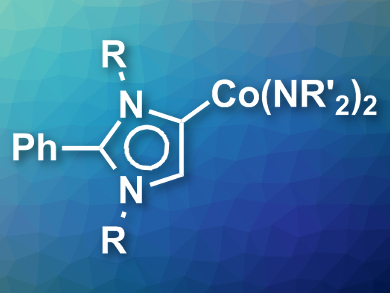N-heterocyclic carbenes (NHCs) are an important class of ligands in organometallic chemistry and their properties can be tuned for applications, e.g., in catalysis. Usually, the ligands bind to the metal center via the C2 atom (between the nitrogen atoms). However, there have been a number of metal complexes with so-called abnormal NHCs (aNHCs), where the ligand binds via the C4 or C5 carbon on the backbone. In this configuration, the ligands are even better σ-donors than “normal” NHCs. Most aNHC complexes so far have been found serendipitously, and approaches for their rational synthesis are scarce.
Rajendra S. Ghadwal, University of Bielefeld, Germany, and colleagues have developed synthetic strategies that lead to two different aNHC-cobalt(II) complexes. The team reacted a C2-arylated imidazolium iodide with Co{N(SiMe3)2}2 in toluene, which gives a complex of the type (aNHC)2CoI2 in 79 % yield. In addition, the reaction of the same imidazolium salt with Na(HBEt3) gives the aNHC transfer agent (aNHC)BEt3. This compound can also be reacted with Co{N(SiMe3)2}2 to give the aNHC complex pictured above.
According to the researchers, this is the first example of a main group compound acting as an aNHC transfer agent. Additionally, the (aNHC)2CoI2 complex could be useful for the synthesis of other cobalt complexes due to the high yield of the reaction and the presence of iodide as leaving groups.
- Facile Routes to Abnormal-NHC-Cobalt(II) Complexes,
Rajendra S. Ghadwal, Jan-Hendrik Lamm, Dennis Rottschaefer, Christian J. Schürmann, Serhiy Demeshko,
Dalton Trans. 2017.
DOI: 10.1039/c7dt01778b




